Bedford: Difference between revisions
mNo edit summary |
No edit summary |
||
| (One intermediate revision by one other user not shown) | |||
| Line 38: | Line 38: | ||
<blockquote><small>1914 † 1919<br>TO BEDFORDIANS WHO DIED, MANY IN EARLY YOUTH, SOME FULL OF YEARS AND HONOUR, BUT WHO ALL ALIKE GAVE THEIR LIVES FOR THEIR COUNTRY.</small></blockquote> | <blockquote><small>1914 † 1919<br>TO BEDFORDIANS WHO DIED, MANY IN EARLY YOUTH, SOME FULL OF YEARS AND HONOUR, BUT WHO ALL ALIKE GAVE THEIR LIVES FOR THEIR COUNTRY.</small></blockquote> | ||
'''Bedford Castle Mound''' is the remnant of Bedford's | '''Bedford Castle Mound''' is the remnant of Bedford's mediæval castle, located close to the centre of the modern town, less than a hundred yards from Bedford Bridge and the High Street. The retaining wall built in 2000 on the riverward side of the mound incorporate a few pieces of original masonry. A paved path leads up to the top of the mound where the keep once stood. | ||
'''Bedford Park''' is the town's largest urban park, located directly to the north of the town centre. The park retains many original features from its Victorian design and construction, including a cricket pavilion and bandstand which are both still in use. | '''Bedford Park''' is the town's largest urban park, located directly to the north of the town centre. The park retains many original features from its Victorian design and construction, including a cricket pavilion and bandstand which are both still in use. | ||
| Line 45: | Line 45: | ||
==Churches== | ==Churches== | ||
[[File:StPaulsChurchBedford.jpg|thumb| | [[File:StPaulsChurchBedford.jpg|right|thumb|200px|St Paul's Church]] | ||
Bedford, the home of John Bunyan, was once at the forefront of non-conformist Protestantism. It retains a large number of reformed churches, but has a wide variety of Christian and non-Christian groups. | Bedford, the home of John Bunyan, was once at the forefront of non-conformist Protestantism. It retains a large number of reformed churches, but has a wide variety of Christian and non-Christian groups. | ||
* [[Church of England]]: | * [[Church of England]]: | ||
** St Paul's ''(see below)'' | **St Paul's ''(see below)'' | ||
** St | **St Peter's, on St Peter's Street: contains some of the oldest architectural remains in Bedford, including two monoliths. | ||
**St Martin, a fine Victorian church, with a bold hanging rood | |||
**Christ Church, in the 1950s style | |||
* Newfrontiers Network: | * Newfrontiers Network: | ||
** (four churches) | ** (four churches) | ||
| Line 60: | Line 61: | ||
===St Paul's Church=== | ===St Paul's Church=== | ||
'''St Paul's Church''', Bedford's principal parish church stands in St Paul's Square. Its lofty spire is one of the town's most visible features. The present church was begun in the early 13th century, on the site of an older church of which nothing remains. John Bunyan (1628-1688) and John Wesley (1703-1791) both preached in the church. | '''St Paul's Church''', Bedford's principal parish church stands in St Paul's Square. Its lofty spire is one of the town's most visible features. The present church was begun in the early 13th century, on the site of an older church of which nothing remains. John Bunyan (1628-1688) and John Wesley (1703-1791) both preached in the church. | ||
In 1865-1868 the tower and spire were completely rebuilt and the two transepts added and lesser alterations have been made since. From 1941 to the end of the Second World War the BBC's daily service was broadcast from St | In 1865-1868 the tower and spire were completely rebuilt and the two transepts added and lesser alterations have been made since. From 1941 to the end of the Second World War the BBC's daily service was broadcast from St Paul's. | ||
==Other religions== | ==Other religions== | ||
Latest revision as of 16:54, 24 October 2015
| Bedford | |
| Bedfordshire | |
|---|---|
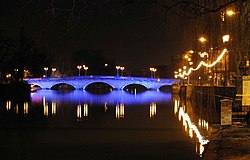 Bedford Town Bridge at night | |
| Location | |
| Grid reference: | TL055495 |
| Location: | 52°8’1"N, 0°27’28"W |
| Data | |
| Population: | 79,190 |
| Post town: | Bedford |
| Postcode: | MK40, MK41, MK42 |
| Dialling code: | 01234 |
| Local Government | |
| Council: | Bedford BC |
| Parliamentary constituency: |
Bedford |
Bedford is the county town of Bedfordshire. According to estimates, the town had a population of 79,190 in mid 2005, with 19,720 in the adjacent town of Kempston. The wider borough, including a rural area, had a population of 153,000.
The Town
Bedford is the major residential and commercial town in northern Bedfordshire. It stands on the banks of the Great Ouse, the heart of the town to the north of the river. It is a busy and prosperous town.
The bustle of the town centre gives way to a parkland to the north and along the river, where the Bedford River Festival is held in each alternate summer.
The town of Kempston is adjacent to Bedford, and serves to some extent as an extension or commuter town for it. The nearby villages are popular with commuters to Bedford, but also to Milton Keynes and to London.

Landmarks
The Embankment is the name given to the gardens lining the Great Ouse as it flows through the town centre. Within these gardens stands a war memorial to the fallen of the First World War, opposite Rothsay Gardens. The memorial was designed in 1921 by the sculptor Charles Sargeant Jagger and depicts a Knight vanquishing a dragon.[1] The inscription reads
1914 † 1919
TO BEDFORDIANS WHO DIED, MANY IN EARLY YOUTH, SOME FULL OF YEARS AND HONOUR, BUT WHO ALL ALIKE GAVE THEIR LIVES FOR THEIR COUNTRY.
Bedford Castle Mound is the remnant of Bedford's mediæval castle, located close to the centre of the modern town, less than a hundred yards from Bedford Bridge and the High Street. The retaining wall built in 2000 on the riverward side of the mound incorporate a few pieces of original masonry. A paved path leads up to the top of the mound where the keep once stood.
Bedford Park is the town's largest urban park, located directly to the north of the town centre. The park retains many original features from its Victorian design and construction, including a cricket pavilion and bandstand which are both still in use.
Priory Country Park is a large country park located on the northern bank of the River Ouse in eastern Bedford.
Churches
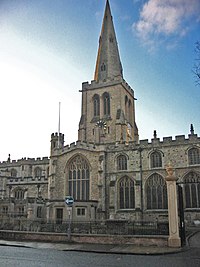
Bedford, the home of John Bunyan, was once at the forefront of non-conformist Protestantism. It retains a large number of reformed churches, but has a wide variety of Christian and non-Christian groups.
- Church of England:
- St Paul's (see below)
- St Peter's, on St Peter's Street: contains some of the oldest architectural remains in Bedford, including two monoliths.
- St Martin, a fine Victorian church, with a bold hanging rood
- Christ Church, in the 1950s style
- Newfrontiers Network:
- (four churches)
- Quaker meeting house
- Roman Catholic:
- (churches include Polish and Italian congregations)
- Independent churches: various
St Paul's Church
St Paul's Church, Bedford's principal parish church stands in St Paul's Square. Its lofty spire is one of the town's most visible features. The present church was begun in the early 13th century, on the site of an older church of which nothing remains. John Bunyan (1628-1688) and John Wesley (1703-1791) both preached in the church.
In 1865-1868 the tower and spire were completely rebuilt and the two transepts added and lesser alterations have been made since. From 1941 to the end of the Second World War the BBC's daily service was broadcast from St Paul's.
Other religions
- Islam: Three mosques
- Sikhism: a temple - the largest in the United Kingdom outside London.
History
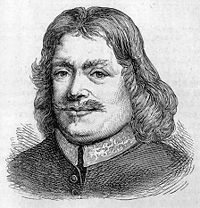
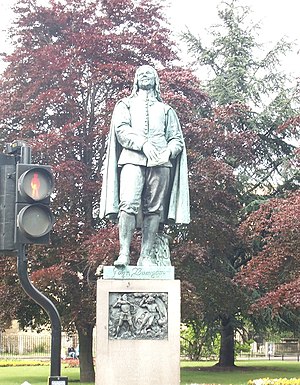
Bedford was a market town for the surrounding agricultural region from the early Middle Ages. King Offa of Mercia was buried in the town in 796.[2] In 886 the Treaty of Wedmore made Bedford a boundary town separating Wessex and the Danelaw.[3] In 919 King Edward the Elder built the town's first known fortress, on the south side of the River Ouse and there received the area's submission. This fortress was later destroyed by the Danes. William II gave the barony of Bedford to Paine de Beauchamp, who built a new stone castle, which was razed in 1224 and today only a mound remains.[4]
In 1166 King Henry II gave Bedford a borough charter[5]. It elected two members to the House of Commons before the Reform Act.
For much of the Middle Ages Bedford remained a small town focussed on industry from agriculture, wool being the county's important industry. Flemings and Huguenots arrived in the 1560s and turned Bedfordshire into a major centre the lace industry.[6] Lace continued to be an important industry in Bedford up until the early 20th century[7]; "Bedfordshire lace" is distinctive technique of lacemaking.
In 1660 John Bunyan was imprisoned for 12 years in Bedford Gaol, where he wrote The Pilgrim's Progress.[8]
In 1689 the River Great Ouse became navigable as far as Bedford. Wool declined in importance with brewing becoming a major industry in the town.
The 19th Century saw Bedford transformed into an important engineering hub. In 1832 gas lighting was introduced, and the railway reached Bedford in 1846. The first Corn Exchange was built 1849,[9] and the first drains and sewers were dug in 1864.[10]
-
Bedford in 1611
-
Bedford Bridge in 1783. This version of the bridge was replaced in 1813.
-
Bedford in 1806
-
Bedford Castle hill
Culture
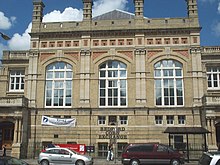
Bedford Museum & Art Gallery is housed in the recreated Victorian home of the Higgins family of Victorian brewers and in a modern extension. The museum has local history collections, while the galleries have notable collections of watercolours, prints and drawings, ceramics, glass and lace.
The Bedford Corn Exchange is the largest entertainment venue in the town and plays host to a variety of performances, meetings, conferences, concerts and private functions. The Corn Exchange also operates the Harpur Suite exhibition hall and the Bedford Civic Theatre which, in 2007 played host to the 'Bedfringe festival', a pre-Edinburgh Fringe festival (Bedfringe has now expanded into multiple venues in the town). The University of Bedfordshire Theatre is the largest theatre in Bedford and hosts many larger productions as well as projects from the university. There is an active amdram (community theatre) scene, with groups such as the Swan Theatre Company, Bedford Dramatic Club (BDC), Bedford Marianettes and ShowCo Bedford producing plays and musicals in venues like the Civic Theatre and the Corn Exchange. The Bedford Pantomime Company produces a traditional pantomime at the Bedford Corn Exchange each Christmas. Esquires (one of the town's premier live music venues) regularly plays host to many notable bands and acts from all over the UK as well as showcasing local live music.
Every two years, an event called "The River Festival" is held near the river in Bedford during early July. The event lasts for two days and regularly attracts about 250,000 visitors. The event includes sports, funfairs and live music. It is the second largest regular outdoor event in the United Kingdom, beaten in numbers only by the Notting Hill Carnival.[11] The Bedford Regatta each May is Britain's largest one-day river rowing regatta.
Other annual events include 'Bedford By The Sea' (when large quantities of sand are deposited in the town centre) and the 'Bedford International Kite Festival' in June. 'Proms In The Park', held in early August, is a popular musical event.
References
- ↑ Daniel Stannard/Bedfordshire County Council (2007). "The First World War Memorial, Bedford". Bedfordshire Buildings and Monuments. http://www.galaxy.bedfordshire.gov.uk/webingres/bedfordshire/vlib/0.digitised_resources/bedfordshire_buildings.pdf. Retrieved 2007-11-04.
- ↑ Simon Keynes, "Cynethryth", in Lapidge, Encyclopaedia of Anglo-Saxon England, p. 133.
- ↑ Whitelock, Dorothy; Douglas, David C. (ed) (1979). English Historical Documents c. 500-1042 (2nd edition). Routledge. http://books.google.com/books?id=EUSqIR2qaaIC&pg=PA416&dq=bedford+886+danes&sig=JmxDJNcfoi60LftEpzKr097ZxuA. Retrieved 2008-02-10.
- ↑ "Bedford Castle". CastleUK. http://www.castleuk.net/castle_lists_midlands/153/bedfordcastle.htm. Retrieved 2008-02-10.
- ↑ "Brief History of Bedford". Bedford Borough Council. http://www.bedford.gov.uk/Default.aspx/Web/BriefHistoryofBedford. Retrieved 2008-02-10.
- ↑ "The Huguenot Influence". The Cowper and Newton Museum. http://www.mkheritage.co.uk/cnm/lace/lacehtml/huguenot.html. Retrieved 2008-01-29.
- ↑ "Lacemaking in Bedfordshire - Introduction". Bedford Borough Council. http://www.bedford.gov.uk/Default.aspx/Web/AragonLacemakers. Retrieved 2008-01-29.
- ↑ "John Bunyan (1628-1688)". The Bunyan Press. http://www.bunyanpress.co.uk/jbunyan.htm. Retrieved 2008-02-10.
- ↑ "1849 & Friday 1 March 1850". Bedford Corn Exchange. http://www.bedfordcornexchange.co.uk/. Retrieved 2008-02-10.
- ↑ "Bedford Borough records introduction". Bedfordshire County Council. http://www.bedfordshire.gov.uk/CommunityAndLiving/ArchivesAndRecordOffice/GuidesToCollections/BedfordBoroughRecordsIntroduction.aspx. Retrieved 2008-02-10.
- ↑ "River Great Ouse". Bedford Borough Council. http://www.bedford.gov.uk/Default.aspx/Web/RiverGreatOuse. Retrieved 2008-01-29.



